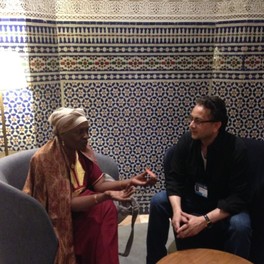I recently attended the Clinton Global Initiative Middle East and Africa meeting in Marrakech, Morocco. As I prepared for the trip, some of my friends and family expressed concerns about my safety. Their worries were understandable -- headlines from the Middle East and North Africa (MENA) focus almost exclusively on seemingly intractable wars, religious hatreds and acts of terrorism. Overall, even when covered sympathetically, the MENA region emerges as a group of fragmented and contentious societies badly in need of help, but incapable of helping themselves.
Nothing could be further from the truth.
While significant development challenges remain in the region, progress is being made in a number of key areas by both governments and local communities. More importantly, cooperation across borders and with international actors is on the upswing. This story might not be as good for ratings as a terrorist massacre. But in recognizing what is truly going on in the region, we gain a better context for evaluating our own potential for constructive contribution.
Here are just a few areas in which progress is hiding in plain sight.
Philanthropy
In 2013, the United Arab Emirates (UAE) became the world's largest donor of official development assistance (ODA), with the highest Official Development Assistance/Gross National Income ratio (ODA/GNI ratio), having made a record leap from 19th position in 2012. The Emirates Foundation for Youth Development has helped more than 28,000 young people make positive contributions to their communities by facilitating social inclusion and volunteer opportunities in civil society.
The UAE is not alone. Saudi Arabian giving also increased in 2013, by a whopping 24%. Over the past decade Saudi Arabia has been the 19th largest government provider of humanitarian assistance.
Beyond raw cash, the network of support among neighboring countries in MENA runs deep. To give just one example, since the outbreak of civil war in Syria, some 680,000 Syrian refugees have found shelter in Jordan. There are many such examples from across the region.
Poverty
In 1995, the Human Development Index of MENA was 0.62. In 2013, it stood at 0.71 - a 15 percent increase in two decades [UNDP Human Development Reports]. The region's per capita gross national income (GNI) in 1995 was $1,178. In 2008 had risen almost 300 percent to $3,456 [World Bank 2009]. While the region's growth in per capita gross domestic product (GDP) of 1.65 percent between 1995 and 2012 might seem weak when compared with South Asia (4.1 percent) or East Asia and the Pacific (3.1 percent), it compares favorably to numbers for Europe and Central Asia (1.6 percent) and Latin America and the Caribbean (1.4 percent) [African Development Bank, Inequality, Economic Growth, and Poverty in the Middle East and North Africa (MENA) Working Paper Series].
Gender
In the area of gender, stereotypes of repression abound. The numbers tell a more complex story. Since 1970, MENA countries have recorded the world's fastest progress in human development. In this period, five MENA countries (Algeria, Morocco, Oman, Saudi Arabia, and Tunisia) have been among the top ten fastest movers. During the same period, the average growth rates of key indicators--such as female literacy, infant mortality, and life expectancy--exceeded those of most other developing regions [UNDP 2010 report]. The MENA region as a whole is close to achieving gender parity in primary and secondary school enrollment rates, and compares favorably to low- and middle-income (LMI) countries worldwide. Maternal mortality in the region is half the world average, and in the past decade, fertility rates have declined rapidly [World Bank MENA Development Report: Opening Doors, Gender Equality and Development in the Middle East and North Africa].
During the past decade, the region made progress in extending the rights of women to vote and run for political office. Saudi Arabia, until recently the only exception, has granted women the right to vote and run for office, beginning with the next round of municipal elections scheduled for 2015. In 2011, Tunisia mandated that an equal number of women and men run as candidates, and women have secured one-quarter of the seats in the constituent assembly - surpassing the female representation within the U.S. Congress.
Private Sector Development
In the Western stereotype, oil is the core business of the region. While petroleum production plays a key role for several exporting nations, MENA economies are actually more complex and their growth - especially important considering a demographic makeup that skews heavily toward youth -- depends on fostering innovation and diversity, as it does anywhere else. In this, they are making strides. According to the Al-monitor report, in no other region in the world is support for the private sector as important as it is in the Middle East and North Africa. In spite of challenges from unemployment and economic and social inequities, the private sector, with its financial clout and knack for innovation, has the potential to help reverse adverse trends. Recent studies show that there was an eight-fold increase in the number of startups in the region between 2005 and 2011. Around 120 venture-capital transactions were completed in MENA in 2009 and 2010, compared to only 62 between 2006 and 2008. This constitutes a clear surge in startups and demonstrates that an entrepreneurial spirit is alive in the region.
Governance
Clearly, not all media coverage of the region is inaccurate. This is indeed a time of intense and accelerated political and social upheaval for most if not all MENA societies, which are struggling to redefine themselves and their relationships with the wider world.
Good governance relationships can be analyzed in a framework based on two universal values that are particularly relevant to the region: inclusive growth and accountability. Most constitutions now enshrine the values of good governance. Governments remain strongly committed to providing citizens with good public services. The debate on governance in the region, hampered though it may be by censorship and limited information, as well as by the fragility of nascent representative institutions, is a reality. While progress may vary in strength and breadth, it is evident on many fronts to some degree.
With corrective intent, President Clinton kicked off the conference with a list of stories like these, ranging from Kenya to Liberia. In one, he quoted a young Kenyan girl who had told him, "Everybody has a story, and it deserves to be heard and respected."
In light of the hard-won progress I see across this region, often against considerable odds and frequently invisible in the face of stereotypical media coverage, her comment resonates. The MENA region has many stories to tell. And we can help. As key players in civil society and especially as members of the development community, we are called upon to support innovative solutions and Smart Development. Increasingly, this also means publicly challenging simplistic narratives that lock us into worn-out and fatalistic viewpoints that impede, rather than facilitate, the kind of community-building on which our cherished outcomes depend.
It means recognizing, and communicating, the truths we see hiding in plain sight.

